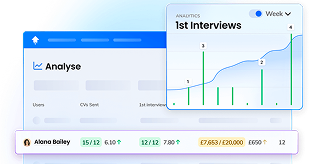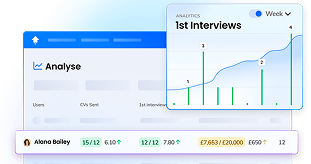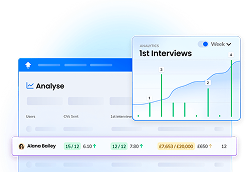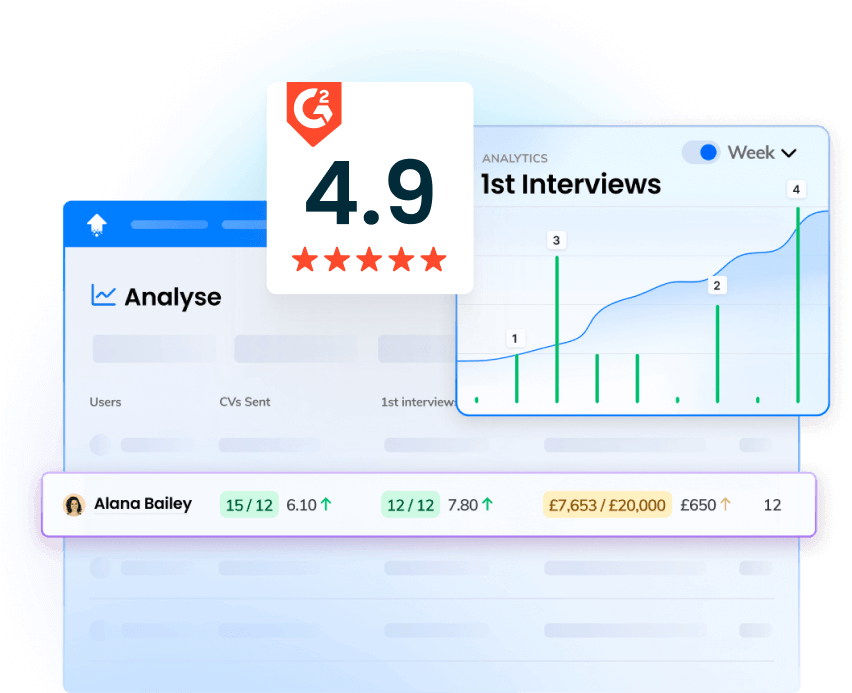Recruitment teams have long struggled to access the data and insights needed to make smart strategic decisions.
For much of the last decade, this problem was masked by the booming jobs market. But now the industry is struggling, optimal business performance is no longer a nice-to-have — it’s essential.
That’s where SMART goals for recruiters come in.
Setting and tracking (the right) goals benefits all areas of a recruitment business, helping you find efficiencies, boost productivity, and generate more revenue. Read on to learn:
- Why are SMART strategic goals for recruiters so important?
- What are the most useful examples of smart goals for recruiters?
- How can you measure and track progress against SMART goals for recruitment?
Let’s get into it…
The significance of SMART goals in recruitment
“SMART” is an acronym that stands for:
- Specific
- Measurable
- Achievable
- Relevant
- Time-Bound
Building goals that follow the SMART framework helps to ensure you can hit them within a specific time-frame. Plus, if you do achieve them, they’ll directly contribute to the overarching objectives of your business.
Let’s take a deeper look at the meaning behind each of those elements:
Specific
For your recruiter performance goals to be specific, they must take into account the following considerations:
- What, exactly, are you trying to achieve?
- What specific actions are required to hit the goal?
- Who is responsible for making those steps happen?
Measurable
When it comes to goal-setting for recruiters, it’s essential that you make them measurable. That way, you can accurately track progress, and there’s no ambiguity about whether or not you’ve hit your target.
Typically, this involves putting a hard number on your goal. For instance, don’t just aim to increase the number of CVs sent — strive for a 30% uplift.
Achievable
Sure, you want to shoot for the stars. But if your performance goals for recruiters aren’t achievable, you’re just setting yourself up for failure.
Consider the challenges that might prevent you from hitting your target, like a lack of resources, expertise, or essential tools. Can you realistically overcome those challenges? If not, your goal probably isn’t achievable.
Relevant
Unless your quarterly, monthly, weekly, or daily goals for recruiters are relevant to the needs of your business, there’s no point even targeting them in the first place. Would increasing the number of calls made actually contribute to your overarching strategic objectives? Or is it just another meaningless vanity metric?
Time-bound
Lastly, your SMART goals for recruiters must be time-bound so everyone understands the deadline they’re working toward. When the big date arrives, it’ll be clear whether you’ve achieved your target.
9 Key SMART Goals for Recruiters to Track in 2025
You could be tracking a huge number of SMART goals. But not all will be equally valuable to your business. With that in mind, we’ve rounded up nine of the most important sample performance goals for recruiters.
Talent acquisition manager performance goals
Here are some potential performance goals for talent acquisition managers to implement:
Example 1: Increasing conversion from Jobs Added to Candidates Placed
This goal helps measure the overall effectiveness of your entire recruitment operation, from the job descriptions you write to the candidate's interview process and experience you deliver.
In an ideal world, every vacant role you promote would result in a successful candidate being placed. But there are various reasons — changes at the client’s end; a lack of suitable talent; offers rejected through unattractive salaries or benefits — that might stop that from happening.
Real-world example: Increase current conversion rate of jobs added to candidates placed by 10% year-on-year.
Example 2: Increase offer acceptance rate
Whereas the previous goal looks at the performance of the whole recruiting process, focussing on offer acceptance rate hones in on what happens at the very end of the recruitment process itself, when the right candidate has been identified and an offer has been made.
Again, every recruiter hopes for a 100% offer acceptance rate. But in a tight labour market, counter-offers have become widespread, with 40% of employers making them in the 12 months leading up to summer 2023 — and 25% of those anticipating more counter-offers in the following 12 months.

Of course, improving your offer acceptance rate doesn’t mean hoping for fewer aggressive counter-offers. It’s more about delivering a superb candidate experience, selling them on a strong employer brand proposition and making job seekers feel genuinely excited about the opportunity, not just about the chance to earn a higher salary.
Real-world example: Increase offer acceptance rate by 12% over the next six months.
Example 3: Decreasing time to hire
While time-to-hire benchmarks vary significantly across different countries and industries, the global average rose to 44 days in Q1 2023, up from 43 days a year earlier. Speed is very much of the essence. A shorter time to hire means:
- Your clients are happier because they find relevant candidates faster
- You get to take on more jobs without growing your recruitment team, helping you boost revenue
As such, decreasing time to hire is one of the key focuses for many talent acquisition managers.
Real-world example: Decrease average time to hire by 5% year on year.
Example 4: Increasing New Clients to Jobs Added ratio
It can be easy for reps to add new clients to their database to hit a "clients added" target. But if those clients aren't adding new jobs with you, it really means nothing. Revenue depends on how many jobs they add.
So focussing on the ratio or average numbers of jobs added per client can be an effective way to determine whether you’re truly adding value with new clients.
Real-world example: Increase the average number of jobs added per client by 10% year on year.
Example 5: Increase hire quality
This metric is a little harder to turn into a SMART goal, because it’s subjective: one client’s definition of a “quality hire” may differ from another’s.
Your goal is to come up with a way to measure hire quality that can be applied to all placements. It could simply be the percentage of new hires who make it through their probation period or remain with the business for at least 12 months. Speak to your clients to understand how they track hire quality and try to also identify areas of commonalities.
Build an internal framework for assessing hire quality, with a regular reporting cadence. This way, you can better understand how quality improves or declines over time.
Real-world example: Improve the number of “quality” hires by 15% over the next 12 months.
Recruiter performance goals
While talent acquisition managers need to focus on the bigger picture, recruiters should work toward more granular metrics. Here are some examples of performance goals for recruiters:
Example 1: Increasing the number of candidate calls
Setting specific productivity targets for your recruitment team ensures everyone understands what’s expected of them. These recruiter goals for performance can also help team managers identify barriers or inefficiencies in their current hiring process that might be holding recruiters back from hitting those goals.
Candidate calls are one of the most important activities to track because they directly relate to the volume of qualified candidates your reps are sourcing.
Real-world example: Increase candidate call volumes by 10% by the end of Q1.
Example 2: Improve ratio of CVs Sent to Interviews Booked
This is a measure of the quality of candidates you're sending to a client. Improving performance against this SMART goal would demonstrate that you're sourcing and sending better candidates, which should improve your chances of placing a candidate.
Real-world example: Improve the ratio of CVs sent to interviews booked by 5% month-on-month.
Personal development goals for recruiters
Fostering a company culture of continued career development is key to building a successful, engaged recruitment team. Examples of goals for recruiters related to personal development include:
Example 1: Build a personal brand
Now more than ever, the most successful recruiters have strong personal brands. They’re seen as trusted experts and advisers, not just people paid to channel CVs from candidates to hiring managers. That means personal branding should be a personal development goal for all recruiters.
While many elements go into developing a personal brand, the most obvious starting point is LinkedIn. As the world’s largest professional social network, it plays a key role in any recruitment marketing strategy. Related SMART recruitment goals could be about building more connections, posting more frequently, or generating higher engagement per post.
Real-world example: Boost your recruitment marketing and recruitment efforts by achieving at least 1,000 LinkedIn connections by the end of the next quarter.
Example 2: Ongoing professional development
The best recruiters are always looking to acquire new skills. That might mean improving their public speaking, writing better emails, or mastering a new software platform.
Again, it can be tricky to translate professional development into a SMART goal. The specifics will vary based on the goal itself, but there must be some way to measure the results. And recruiters must have access to the necessary tools and resources — otherwise their goals won’t be achievable.
Real-world example: Complete all sections of the “Learning LinkedIn Recruiter” course in the next three months.
SMART goals implementation: 4 success strategies
Just because you’ve set one or more SMART goals for recruiters, that doesn’t automatically mean you’ll hit them. If you don’t implement your goals effectively, they can quickly go from being a top priority to slipping off your radar altogether. Use these strategies to keep your SMART goals at front of mind:
Communicate goals to your team
It’s highly unlikely you’ll achieve your SMART goals single-handedly. So the first step in hitting your targets is to explain them to your team.
Don’t just give them the headline figures you’re trying to achieve; provide the context behind those numbers to make your goal more meaningful. For instance, rather than telling them that you want to increase call volumes, explain that you’re rolling out a new auto dialler to help with productivity levels.
Also, when setting SMART recruitment goals, be sure to set more granular sub-goals where relevant to increase accountability, such as breaking down your team-level call goal into targets for individual recruiters.
Align goals and values
To an extent, your team has to get onboard with your SMART goals, because it’s their job. But you’re far more likely to get buy-in from your team if your goal aligns with their values.
There’s no blanket approach to this, because no two recruitment teams share exactly the same values. Whether they’re motivated by personal improvement, being part of a successful, growing business, or generally making the world a better place, make it clear how their actions will contribute to the things they care about.
Plan for recruitment success
You can’t predict every speed bump that might come your way. But some challenges can absolutely be foreseen. You’re far more likely to implement your SMART goals effectively if you can plan for them and come up with solutions before they arise.
Let’s consider a hypothetical example: you want to decrease cost per hire. After reviewing your current processes and workflows, you realise the best approach is to reach more prospective employees. But you don’t have any budget to target job searchers with paid ads. Securing that ad spend could play a key role in hitting your target.
Track progress regularly
Recruitment agencies are busy places. With so many different priorities, it’s easy to lose focus on your SMART goals. And if you don’t pay them enough attention, you’ll never implement them effectively.
For that reason, get into the habit of regularly tracking progress against your goals and sharing the progress with your team.
Measuring and tracking progress
We know that regularly measuring progress is vital if you’re going to implement and achieve your SMART goals. It also allows you to make data-driven strategic decisions rather than relying on gut feeling.
Unfortunately, for many recruitment businesses, this process is harder than it should be.
Recruiting software is a major limitation: recruitment CRMs are often outdated and more sophisticated platforms like Power BI and Tableau have frustratingly steep learning curves.
That forces many recruitment businesses to rely on labour-intensive manual alternatives (i.e. spreadsheets), which means managers waste time building reports and trying to pull insights from multiple other disconnected recruitment tools.
But it doesn’t have to be like that.
Improve measuring and tracking with OneUp
OneUp is the perfect solution for recruitment businesses looking to overcome their data visibility and performance measurement challenges.
![]()
Our recruitment analytics software enables you to build reports in minutes rather than hours and acts as a single source of truth by bringing together real-time data from multiple platforms. Whatever recruiting metrics you’re interested in, you can visualise performance across the day, week, month, quarter, or year, then dig deeper to find the context behind the numbers.
And by automating your reports and updates, you get to save time, safe in the knowledge that the data you need is ready and waiting for you.
All those efficiencies have huge productivity benefits. One recruitment business saw a 28% increase in client calls, a 75% upturn in interviews, and a 149% boost in CVs sent after implementing OneUp.
Conclusion
SMART goals are essential to the growth of your recruitment business. Without them, you can never be totally sure that you’re heading in the right direction.
But they’re not a silver bullet.
Without the right performance-tracking tools in place, you’ll never unlock the full benefits of SMART goals, because you’ll waste too much time rounding up all the data and insights you need from various other platforms.
Take the first step toward building a more effective recruitment tech stack by booking your OneUp product demo today.




















